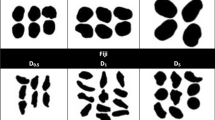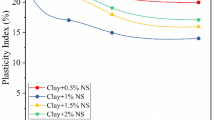Abstract
The aim of this study was to investigate the shear stress and deformation contribution of soil particle on silt loam and silt clay textural classes. The soil types of the study area are Hypereutric Vertisols and Rhodic Cambisols. Finite element method (ANSYS) was used to emphasize the locations and determine the amount of shear stress and deformation of soil particles, and IBM SPSS was used for analysis and verification of the results. The laboratory tests and fieldwork experiments were performed in order to determine the input data for finite element analysis. As a result, when draft forces of 615, 815, 1115, 1315, and 1515 N, the maximum shear stress created by clay soil particles is 4239.8 Pa, and the maximum deformation is 0.22 mm. The maximum shear stress in silt loam soil is found in silt soil particles (3713.6 Pa), and soil deformation was also created by silt soil particles (0.21 mm). The maximum shear stress in silt clay soil is found in clay soil particles (2247.09 Pa), and the maximum soil deformation is created by silt soil particles (0.10 mm). Level of fitness (R2) is 0.99%. This research is a great input for agricultural tillage tool designers and the farmers to develop effective design and maximum performance.





Similar content being viewed by others
REFERENCES
N. H. Abu-Hamdeh and R. C. Reeder, “A nonlinear 3D finite element analysis of the soil forces acting on a disk plow,” Soil Tillage Res. 74 (2), 115–124 (2003). https://doi.org/10.1016/S0167-1987(03)00152-1
M. T. Barral, M. Arias, and J. Guérif, “Effects of iron and organic matter on the porosity and structural stability of soil aggregates,” Soil Tillage Res. 46 (4), 261– 272 (1998). https://doi.org/10.1016/S0167-1987(98)00092-0
J. B. Burland, B. B. Broms, and V. F. B. de Mello, “Behaviour of foundations and structures,” in Proceedings of the International Conference on Soil Mechanics and Foundation Engineering (Tokyo, 1977), pp. 495–536.
S. Gebregziabher et al., “Animal drawn tillage, the Ethiopian ard plough, maresha: a review,” Soil Tillage Res. 89 (2), 129–143 (2006). https://doi.org/10.1016/j-.2005.08.010
V. Guerriero and S. Mazzoli, “Theory of effective stress in soil and rock and implications for fracturing processes: a review,” Geosciences 11 (3), (2021). https://doi.org/10.3390/geosciences11030119
Confirmatory Factor Analysis for Applied Research, Ed. by D. A. Kenny (2007), Vol. 44, No. 5. https://doi.org/10.5860/choice.44-2769
J. G. B. Leenaars, E. Eyasu, H. Wösten, M. Ruiperez González, B. Kempen, A. Ashenafi, and F. Brouwer, Major Soil-Landscape Resources of the Cascape Intervention Woredas, Ethiopia: Soil Information in Support to Scaling up of Evidence-Nased Best Practices in Agricultural Production (2016), No. OT-CP2016-1.
F. G. Okyere et al., “Analysis of draft force requirement of a compact disc harrow and model development for future predictions,” J. Biosyst. Eng. 44 (2), 47–56 (2019). https://doi.org/10.1007/S42853-019-00003-3
Q. Pan, G. Reitmayr, and T. Drummond, “ProFORMA: probabilistic feature-based on-line rapid model acquisition,” in Proceedings of British Machine Vision Conference (2009). https://doi.org/10.5244/C.23.112.
D. Tsige, M. Korita, and A. Beyene, “Deformation analysis of cement modified soft clay soil using finite element method (FEM),” Heliyon 8, e09613 (2022). https://doi.org/10.1016/j.heliyon.2022.e09613
M. Ucgul, C. Saunders, and J. M. Fielke, “Comparison of the discrete element and finite element methods to model the interaction of soil and tool cutting edge,” Biosyst. Eng. 169, 199–208 (2018). https://doi.org/10.1016/j.biosystemseng.2018.03.003
Z. Fu, G. Wang, W. Song, Y. Yu, P. Wei, and T. Wu, “Deformation behavior of saturated soft clay under cyclic loading with principal stress rotation,” Appl. Sci. 11, (2021). https://doi.org/10.3390/app11198987
ACKNOWLEDGMENTS
The authors thank Wolkite University (WKU), the Ethiopian Ministry of Education, and Adama Science and Technology University for their contribution in freeing us from other responsibilities for this research. In addition, the authors would like Dr. Fikeru Abiko for his invaluable suggestions, guidance and unwavering support throughout the process, which greatly contributed to his comprehensive understanding of the subject. Our special thanks go to all the staff members of Wolkite laboratory technical for their committed and active participation during laboratory work.
Funding
This research did not receive any specific grants from funding agencies in the public, commercial, or not-for-profit sectors.
Author information
Authors and Affiliations
Corresponding author
Ethics declarations
The authors declare to confirm that there are no conflicts of interest associated with this publication.
Additional information
Publisher’s Note.
Pleiades Publishing remains neutral with regard to jurisdictional claims in published maps and institutional affiliations.
Supplementary Information
Rights and permissions
About this article
Cite this article
Thomas, G., Teshome, Y. & Amana, W. Model of Soil Particles to Investigate Shear Stress and Deformation in Silt Loam and Silt Clay Soil Using Finite Element Method. Eurasian Soil Sc. 56 (Suppl 2), S317–S324 (2023). https://doi.org/10.1134/S1064229323601774
Received:
Revised:
Accepted:
Published:
Issue Date:
DOI: https://doi.org/10.1134/S1064229323601774




